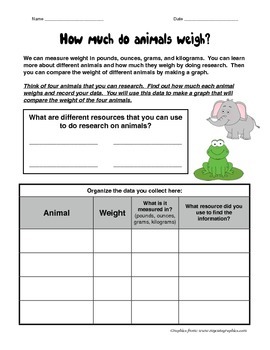Animal Weight Graph
Beth Tice
153 Followers
Grade Levels
3rd - 4th
Subjects
Resource Type
Standards
CCSS3.MD.A.2
CCSS3.MD.B.3
CCSS4.MD.A.2
CCSSRI.3.1
CCSSRI.3.5
Formats Included
- PDF
Pages
3 pages
Beth Tice
153 Followers
Description
Combine nonfiction reading, research, math, and science in one activity! Students can use this document to plan research and collect data on the weights of four different animals. On the recording chart, they indicate what each animal's weight was measured in (pounds, ounces, grams, or kilograms), and from what source they got the information. They use the data that they collect to make a graph to compare the animals' weights. Finally they answer questions about the graph and even make a question of their own for a friend to answer!
See my other product listings for more scaffolded graphing activities that integrate math, science, and nonfiction reading!
See my other product listings for more scaffolded graphing activities that integrate math, science, and nonfiction reading!
Total Pages
3 pages
Answer Key
N/A
Teaching Duration
1 hour
Report this resource to TPT
Reported resources will be reviewed by our team. Report this resource to let us know if this resource violates TPT’s content guidelines.
Standards
to see state-specific standards (only available in the US).
CCSS3.MD.A.2
Measure and estimate liquid volumes and masses of objects using standard units of grams (g), kilograms (kg), and liters (l). Add, subtract, multiply, or divide to solve one-step word problems involving masses or volumes that are given in the same units, e.g., by using drawings (such as a beaker with a measurement scale) to represent the problem.
CCSS3.MD.B.3
Draw a scaled picture graph and a scaled bar graph to represent a data set with several categories. Solve one- and two-step “how many more” and “how many less” problems using information presented in scaled bar graphs. For example, draw a bar graph in which each square in the bar graph might represent 5 pets.
CCSS4.MD.A.2
Use the four operations to solve word problems involving distances, intervals of time, liquid volumes, masses of objects, and money, including problems involving simple fractions or decimals, and problems that require expressing measurements given in a larger unit in terms of a smaller unit. Represent measurement quantities using diagrams such as number line diagrams that feature a measurement scale.
CCSSRI.3.1
Ask and answer questions to demonstrate understanding of a text, referring explicitly to the text as the basis for the answers.
CCSSRI.3.5
Use text features and search tools (e.g., key words, sidebars, hyperlinks) to locate information relevant to a given topic efficiently.




